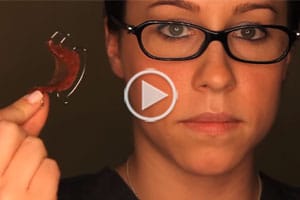The benefits of orthodontic treatment will last a lifetime if you wear your orthodontic retainers. Keep these important patient responsibilities in mind:
Removable Retainers
Once the active orthodontic appliances are removed, the patient will receive retainers to stabilize the dental correction. Because the bone and soft tissues surrounding the teeth are stabilizing for several months after braces are removed, it is imperative that the retainers are worn as instructed. Failure to wear the retainers may result in undesirable movement of the teeth, which could necessitate re-treatment.
How retainers are worn
Because teeth can continue to move throughout life, we feel that individuals who have undergone orthodontic therapy should utilize their retainers indefinitely.
- A patient should wear their retainers 8 – 12 hours following the removal of braces.
- After one visit, 8 hours per day of retainer wear is sufficient for most patients. If prolonged pressure is felt when the retainers are inserted, then the patient will need additional time per day utilizing their retainers.
- This retainer regimen is continued until growth and development of the face is completed and the wisdom teeth have been decided on. Growth and development of the face is completed between 19 – 21 years of age for males and 17 – 19 years of age for females.
- After the face has finished growing, patients may begin testing with their retainers. Testing is a procedure which requires the patient to try in their retainers prior to going to bed. If pressure is felt, then the retainer would be worn that evening. If the retainers feel passive, then the retainers would not need to worn that evening. To maintain the guarantee that the retainers provide for you, the testing procedure is repeated every evening for however long the patient wants to protect their orthodontic result.
- Dr Sacramone will see you every year, if you choose, to check your retainers and to make recommendations on the wisdom teeth.
How to Care for Orthodontic Retainers
- Retainers are made of a thermoplastic material that is sensitive to excessive heat, so they should be kept away from heaters, dishwashers, car dashboards or any place where the temperatures exceed 115 degrees (Fº).
- Retainers should be kept in the proper retainer case when they are not in the patient’s mouth.
- Keep away from any family pets, as they like to chew on them.
- Clean before and after placement in the mouth. Because the material used for fabrication is slightly porous, plaque tends to cling to the surfaces. Gentle scrubbing with a toothbrush and a mild liquid soap will remove the plaque. A denture cleaning solution, such as Efferdent, will aid in the removal of plaque and tartar. Be sure to rinse the retainers thoroughly after cleaning to remove any cleanser residue.
Because retainers are worn for years, they will need periodic replacement. Your original treatment contract includes one set of retainers after the braces are removed. If the retainers are lost or damaged due to neglect, there will be a charge for replacement. If the retainers become loose or break, contact our office immediately.
Fixed retainers (Bonded Wire)
Dr. Sacramone on very rare occasions will utilize fixed retainers. We prefer removable retainers. Fixed retention was developed with the premise that these retainers could be removed once the teeth stopped moving. We once thought that teeth would stop moving once growth and development was complete. That was inaccurate! We now know that your teeth move your entire life. This means that the fixed retainer should stay in place for ever. We feel that this will expose the patient to an increased risk of developing decay and periodontal disease. Which is why we recommend removable retention.
Habits or Conditions that Require Stronger Retention
- Mouth breathing
- Clenching and/or grinding of teeth (muscle hyperactivity)
- Tongue thrusting, low tongue posture or abnormal tongue posture
- Playing musical instruments with a reed
- Lip sucking
- Pen or pencil biting
- Spacing between the teeth prior to treatment
- Severely rotated teeth
Our goal is to help your smile stay beautiful and healthy for a lifetime. Your cooperation is essential in order to achieve this goal.
Dental examinations and cleanings
The patient should continue with proper oral hygiene procedures at home, to include thorough brushing and flossing techniques. His or her family dentist should see the patient at least every six months for cleaning and dental examinations.
